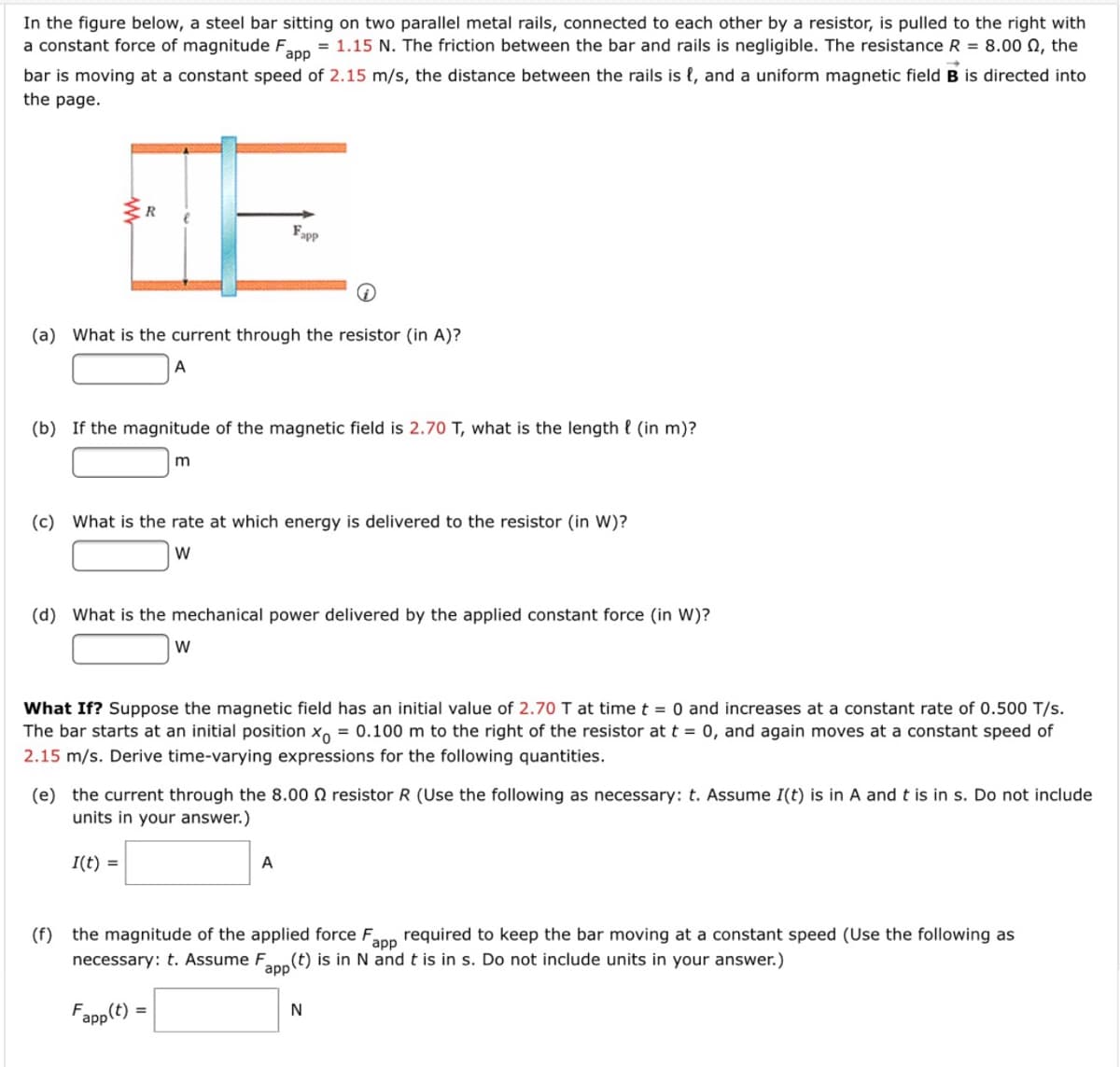In the figure below, a steel bar sitting on two parallel metal rails, connected to each other by a resistor, is pulled to the right with a constant force of magnitude F = 1.15 N. The friction between the bar and rails is negligible. The resistance R = 8.00 N, the app bar is moving at a constant speed of 2.15 m/s, the distance between the rails is {, and a uniform magnetic field B is directed into the page. R Fapp (a) What is the current through the resistor (in A)? A (b) If the magnitude of the magnetic field is 2.70 T, what is the length { (in m)? m (c) What is the rate at which energy is delivered to the resistor (in W)? W
In the figure below, a steel bar sitting on two parallel metal rails, connected to each other by a resistor, is pulled to the right with a constant force of magnitude F = 1.15 N. The friction between the bar and rails is negligible. The resistance R = 8.00 N, the app bar is moving at a constant speed of 2.15 m/s, the distance between the rails is {, and a uniform magnetic field B is directed into the page. R Fapp (a) What is the current through the resistor (in A)? A (b) If the magnitude of the magnetic field is 2.70 T, what is the length { (in m)? m (c) What is the rate at which energy is delivered to the resistor (in W)? W
Physics for Scientists and Engineers: Foundations and Connections
1st Edition
ISBN:9781133939146
Author:Katz, Debora M.
Publisher:Katz, Debora M.
Chapter32: Faraday’s Law Of Induction
Section: Chapter Questions
Problem 71PQ: Two frictionless conducting rails separated by l = 55.0 cm are connected through a 2.00- resistor,...
Related questions
Concept explainers
Angular speed, acceleration and displacement
Angular acceleration is defined as the rate of change in angular velocity with respect to time. It has both magnitude and direction. So, it is a vector quantity.
Angular Position
Before diving into angular position, one should understand the basics of position and its importance along with usage in day-to-day life. When one talks of position, it’s always relative with respect to some other object. For example, position of earth with respect to sun, position of school with respect to house, etc. Angular position is the rotational analogue of linear position.
Question
I need help with part ( e) (f) please
Thanks

Transcribed Image Text:In the figure below, a steel bar sitting on two parallel metal rails, connected to each other by a resistor, is pulled to the right with
a constant force of magnitude F
= 1.15 N. The friction between the bar and rails is negligible. The resistance R = 8.00 N, the
app
bar is moving at a constant speed of 2.15 m/s, the distance between the rails is {, and a uniform magnetic field B is directed into
the page.
R
Fapp
(a) What is the current through the resistor (in A)?
A
(b) If the magnitude of the magnetic field is 2.70 T, what is the length { (in m)?
m
(c) What is the rate at which energy is delivered to the resistor (in W)?
W
(d) What is the mechanical power delivered by the applied constant force (in W)?
W
What If? Suppose the magnetic field has an initial value of 2.70 I at time t = 0 and increases at a constant rate of 0.500 T/s.
The bar starts at an initial position x, = 0.100 m to the right of the resistor at t = 0, and again moves at a constant speed of
2.15 m/s. Derive time-varying expressions for the following quantities.
(e) the current through the 8.00 N resistor R (Use the following as necessary: t. Assume I(t) is in A and t is in s. Do not include
units in your answer.)
I(t) =
A
(f) the magnitude of the applied force F
app
required to keep the bar moving at a constant speed (Use the following as
necessary: t. Assume F
(t) is in N and t is in s. Do not include units in your answer.)
app
Fapp(t)
Expert Solution
This question has been solved!
Explore an expertly crafted, step-by-step solution for a thorough understanding of key concepts.
This is a popular solution!
Trending now
This is a popular solution!
Step by step
Solved in 2 steps with 2 images

Knowledge Booster
Learn more about
Need a deep-dive on the concept behind this application? Look no further. Learn more about this topic, physics and related others by exploring similar questions and additional content below.Recommended textbooks for you

Physics for Scientists and Engineers: Foundations…
Physics
ISBN:
9781133939146
Author:
Katz, Debora M.
Publisher:
Cengage Learning

Principles of Physics: A Calculus-Based Text
Physics
ISBN:
9781133104261
Author:
Raymond A. Serway, John W. Jewett
Publisher:
Cengage Learning


Physics for Scientists and Engineers: Foundations…
Physics
ISBN:
9781133939146
Author:
Katz, Debora M.
Publisher:
Cengage Learning

Principles of Physics: A Calculus-Based Text
Physics
ISBN:
9781133104261
Author:
Raymond A. Serway, John W. Jewett
Publisher:
Cengage Learning


Physics for Scientists and Engineers, Technology …
Physics
ISBN:
9781305116399
Author:
Raymond A. Serway, John W. Jewett
Publisher:
Cengage Learning

Physics for Scientists and Engineers with Modern …
Physics
ISBN:
9781337553292
Author:
Raymond A. Serway, John W. Jewett
Publisher:
Cengage Learning

College Physics
Physics
ISBN:
9781285737027
Author:
Raymond A. Serway, Chris Vuille
Publisher:
Cengage Learning